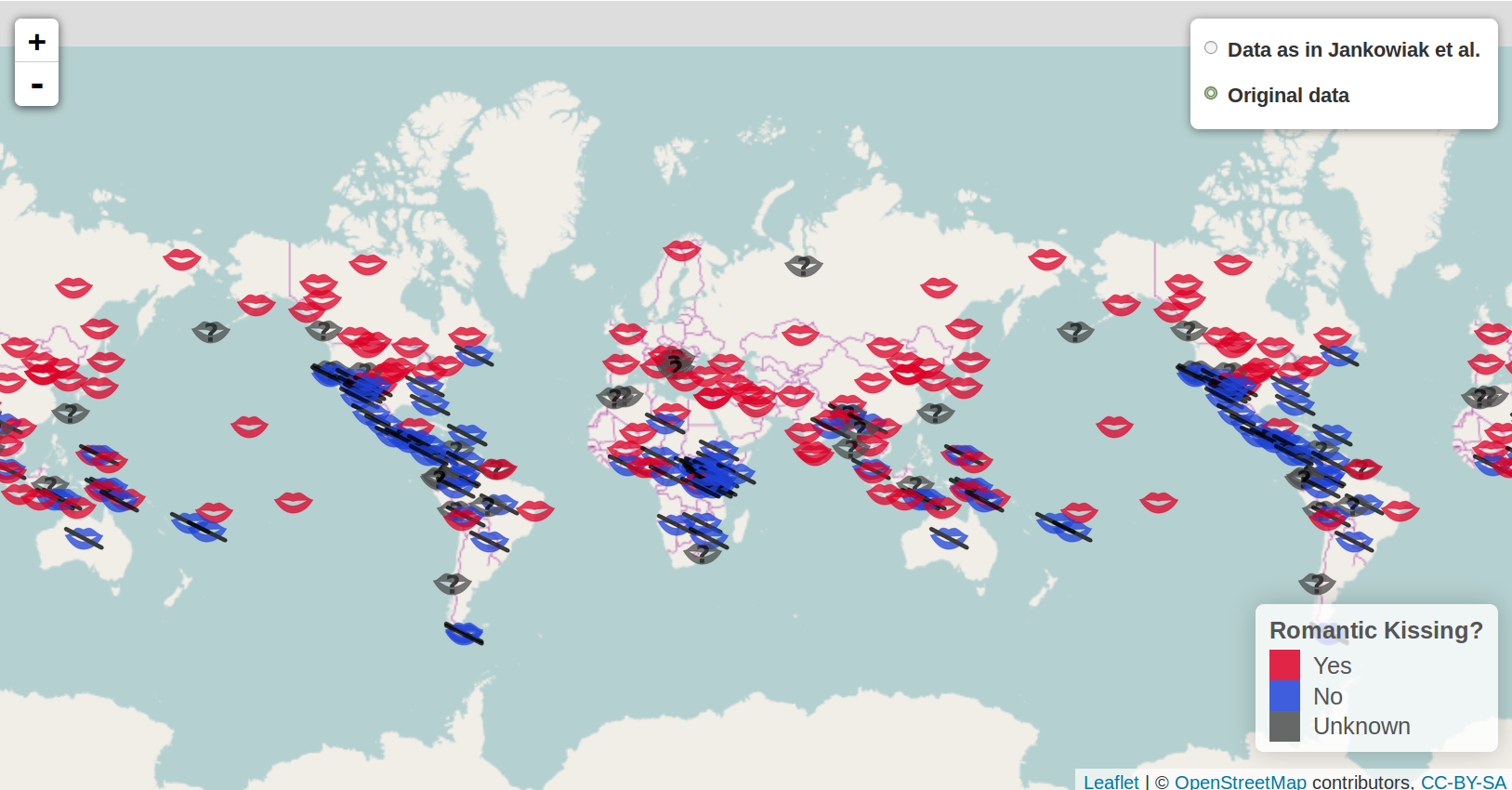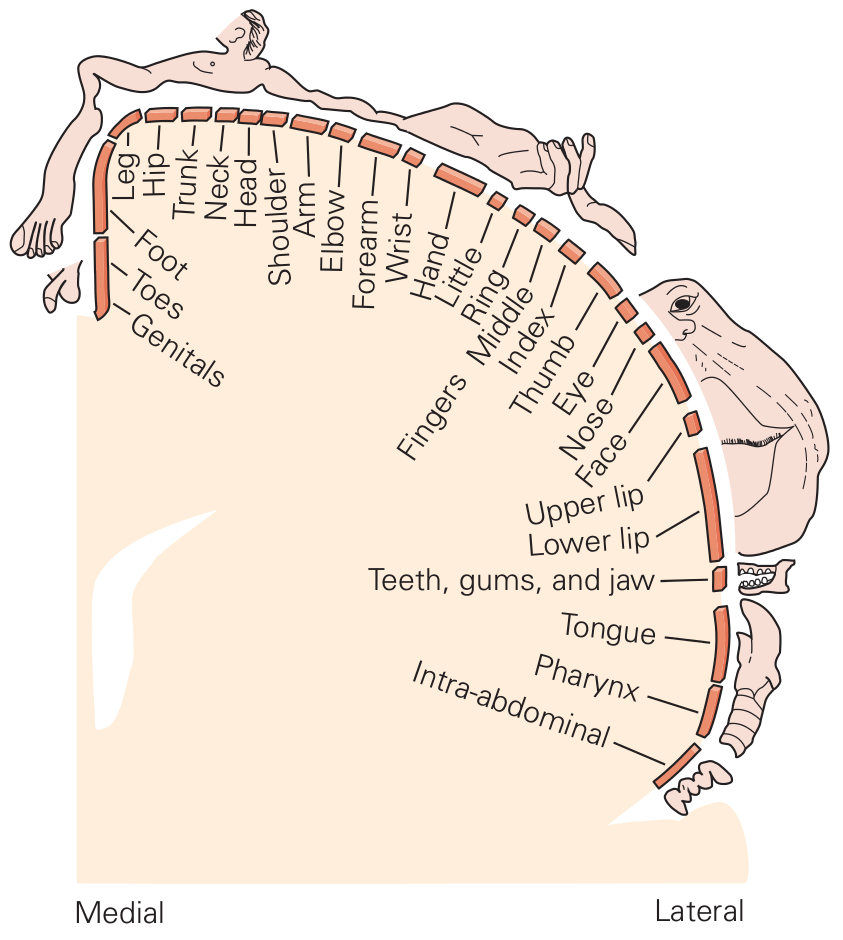Are lips good for love-making?
A comment on Jankowiak et al. (2015) “Is the Romantic–Sexual Kiss a Near Human Universal?”
In an article featured in the September issue of American Anthropologist (here), Jankowiak and co-authors take up the question of whether sexual kissing is a human universal or a culture-specific practice (pdf). While strongly reminiscent of the (in)famous anthropologist-eat-anthropologist debates (adolescence in Samoa, anyone?), which stir bad blood but seldom lead to any kind of consensus, the “kissing problem” has the big advantage of being methodologically tractable. Kissing is directly observable, making the claims for its universal presence – or lack of such – directly falsifiable. If the authors are right and kissing is found only in a minority of world cultures, the anti-universalist argument in this case has a solid empirical basis. If, on the other hand, the data does not stand up to a closer scrutiny, this may be a suitable occasion to catch relativists by the tail. Most importantly, a better understanding of the true distribution of practices such as romantic kissing, which are variously claimed to be grounded in human biology or in social learning, is important for further theoretical work. So let us take a closer look at the “kissing problem”: the claims made by the authors, the evidence these claims are based upon, some implications and alternative explanations.
Jankowiak et al. (2015) have sampled 27 cultures from the Standard Cross-Cultural Sample (SCCS; Murdock and White, 1969) and 128 cultures from the electronic Human Relations Area Files World Cultures (eHRAF). In addition, they have contacted 88 ethnographers to find out whether people in different cultures were known to kiss mouth-to-mouth in a sexual context. All in all, 168 cultures are included in their dataset, and it turns out that only 46% of these (77 out of 168) engage in romantic kissing. In particular, this practice appears to be completely unknown among Sub-Saharan African, New Guinea, or Amazonian foragers or horticulturalists. Kissing also correlates with social complexity: it is present in only 29% of egalitarian, 37% of simple stratified and 82% of complex stratified societies. The conclusion, therefore, is that romantic kissing is a culture-specific practice and cannot be considered a human universal.
One can only applaud the authors' effort to collect extensive evidence on such a theoretically interesting question. However, it would be nice to know which cultures supposedly have romantic kissing and which do not. My colleague Rasmus Bååth, a cognitive scientist at Lund University, Sweden, has obtained the original dataset from the authors and produced this interactive map of kissing in the world, which can be accessed online here. As pointed out in his blog, we may not have located all the cultures correctly, and corrections are very welcome! Beyond geographical location, however, the map shows clearly which cultures are not included. The dataset can easily be extended, given some good will and cooperation. Starting with the data available in the original publication, however, certain aspects of the analysis are open to critique, as discussed below.

Source: http://sumsar.net/files/academia/map_of_romantic_kissing.html. Don't forget to check out Rasmus's blog for an interactive version!
1) Handling of missing data.
In the original dataset, 24 cultures are coded as “unknown”, i.e. we do not know whether kissing is present or absent in these cultures. Nevertheless, in the article they are all counted as non-kissing. Statistically, treating all missing data as evidence in favor of the research hypothesis is a highly questionable approach. The authors acknowledge that the absence of evidence does not prove the absence of behavior, so that we may expect the true proportion of kissing to be somewhat higher than reported. In the light of this proviso, it is particularly strange to treat all “unknown” cases as non-kissing. If we exclude these 24 countries from the analysis, the proportion of “kissers” increases from 46% to 53%. However, since the selection criteria are not made explicit, even this corrected proportion may not be meaningful (see below).
2) Sampling: inclusion criteria and selection bias.
It is not explicitly stated how cultures were selected, but the reader is left with the impression that every culture for which it was at all possible to obtain reliable data was included in the analysis. An inspection of the dataset, however, shows that a very large number of obvious candidates were omitted. In Europe, for instance, we have the following cultures: British, Saami, Albanian, Bosnian Muslim, Croats, Greeks, Montenegrins, Serbs, Basque, and Imperial Rome (?). Albanians, Montenegrins and Serbs are classified as “unknown” (one wonders whether the difficulty of finding informants in these cultures was truly unsurmountable). As a result, the conclusion reported in the final publication and picked up by mass media – 30% of European cultures do not engage in romantic kissing – appears strange once the actual dataset is examined. The actual proportion of kissers in Europe, it may be suspected, is much closer to 100% than to 70%. In general, such percentages are only meaningful if we are dealing with either a census (i.e. if every single culture in the world is included) or with something at least approaching a random sample, as in opinion polls. Instead, it appears that Jankowiak et al. (2015) searched very hard for the most “exotic” cultures in every part of the world, which is rather like polling only millionaires to predict the winner of the next presidential election.
The reason for this sampling bias is presumably an attempt to avoid “contamination” with Western cultural values, and the authors report that they mostly focused on nonindustrial societies. There may be three problems with this approach. Firstly, the sample is skewed towards small minority groups, which makes it less representative of the planet as a whole. Secondly, this selection bias makes the empirical claims harder to verify because of the paucity of evidence: while a claim that the Serbs do not kiss may be easily verified, it is harder to find solid evidence about a tribe of 200 people, especially if the period referred to is not the present but some early-contact phase. This consideration must be taken into account before we accept the authors' own explanation of why kissing is so much less common among egalitarian hunter-gatherer groups (“oral hygiene or the rise of elite social classes that value self-control of affect and emotional displays”, p. 4). Thirdly, many of the non-kissing cultures are closely related and/or come from the same geographic area, while extremely diverse and numerous groups often receive a single entry. For instance, there are three separate entries for the African Pygmies (Aka pygmy, Aka / Bayaka, Mbuti, all three non-kissers), two for the nearly extinct aboriginal tribes of Tierra del Fuego (Ona and Yahagan, both non-kissers), and one for the 1.2-billion strong Han Chinese.
3) Interpretation of the results.
Let us assume, for the sake of the argument, that the problems mentioned above do not nullify the main result: lovers in many of the world cultures do not kiss. What conclusions can we draw from this observation? According to Jankowiak et al. (2015), “Western ethnocentrism—that is 'the belief that a behavior currently deemed pleasurable must be a human universal'—may be driving the common misconception that romantic–sexual kissing is a (near) universal” (p. 3). In other words, just because people in the West experience kissing as sexually arousing and pleasant, this does not mean that people everywhere will agree, i.e. that this function of kissing is biologically predetermined. Instead, “kissing may well serve to bolster the pair-bond relationship, by way of biobehavioral partner assessment or conforming to the imagined cultural sexual script… [T]he romantic–sexual kiss may be a seemingly pleasurable part of sexual repertoires that vary across place and time but anchors on the truly universal human capacity for romantic love” (pp. 4-5). They dismiss the arguments offered by evolutionary psychologists and based on the idea that kissing must be adaptive to be so widespread – since kissing is not at all widespread, the authors claim, it can hardly be a product of evolution.
It appears to me that a different explanation is more plausible. If it is true that romantic kissing is absent in many cultures – although it remains uncertain how many – this behavior requires social learning to manifest itself. The same is true of many animal behaviors, including those with a strong innate component (in humans, language is an obvious example). But we may ask ourselves: why is it so that among the 7 billion people in the world today, an overwhelming majority engage in this socially learned and purely culture-specific behavior, which pre-contact aboriginal groups supposedly found so disgusting? Western cultural hegemony seems to be a weak answer – other disgusting Western inventions, such as direct democracy and human rights, are much less successful at being adopted all over the world. Why did kissing spread like wildfire (if it really had to spread)?
The answer, as it seems to me, lies in the primary somatosensory area in the cortex, in which different body parts have representations proportional to the number of skin receptors – the higher receptor density, the larger the corresponding region of the cortex. Look at the resulting sensory homunculus below:


Left: somatosensory homunculus. Source: Kandel et al. (2013), p. 364, Fig. 16-6.
Right: a popular representation of the same homunculus. Source: google images.
The homunculus has disproportionately large hands, lips, and tongue. These are the body parts with the potential to bring in a lot of information and contribute greatly both to cognitive tasks, such as reading Braille or recognizing different materials by touch, and to emotionally valenced somatosensory experiences – pain as well as sensual pleasure. Observe that these areas do not coincide with the so-called "erogenic zones": the area corresponding to the genitalia is moderately sized, despite the high pleasure potential (we will for the moment ignore the typical male bias in the illustrations). Instead, the well-developed regions in the homunculus are best thought of as "feelers" that can be used to explore the world through touch.
Making love, as some savvy people in the West have discovered, can be a lot more fun if you engage the areas with rich somatosensory innervation. If mouth-to-mouth kissing really is a cultural practice that spreads through diffusion, it would have an enormous advantage over alternative ways of making out (yes, rubbing noses may be fun as well, but look at the relative size of the respective areas in the cortex!). In fact, any cultural practice is more likely to arise and be maintained if it rests upon a solid biological foundation which provides a transmission bias (Richerson & Boyd, 2005; Sperber & Cladiere, 2008). In this case this foundation might be the relative sensitivity of different body parts and the insatiable desire of Homo sapiens to taste (forgive the pun!) everything that life has to offer. Imagine you are the sensory homunculus about to hug and caress a fellow creature – which body parts would you use? It may be that Jankowiak and co-authors are correct, perhaps less than half of the world cultures have figured out what feels good. Perhaps. But personally, I don't think so.
Written by Andrey Anikin: andrey.anikin{at}lucs.lu.se
Interactive map by Rasmus Bååth: rasmus.bååth{at}lucs.lu.se

A couple engaged in romantic kissing and touching. Source: wikiHow.
References
Jankowiak, W.R., Volsche, S.L. & Garcia, J.R. (2015). Is the Romantic-Sexual Kiss a Near Human Universal? American Anthropologist, 117(3), 535-539. doi: 10.1111/aman.12286 pdf
Kandel, E. R., Schwartz, J. H., Jessell, T. M., Siegelbaum, S. A., & Hudspeth, A. J. (2013). Principles of neural science. Fifth edition. McGraw-Hill, New York.
Murdock, G. P., & White, D. R. (1969). Standard cross-cultural sample. Ethnology 8(4), 329-369.
Richerson, P. J., & Boyd, R. (2005). Not by genes alone: How culture transformed human evolution. University of Chicago Press.
Sperber, D., & Claidière, N. (2008). Defining and explaining culture (comments on Richerson and Boyd, Not by genes alone). Biology & Philosophy, 23(2), 283-292.